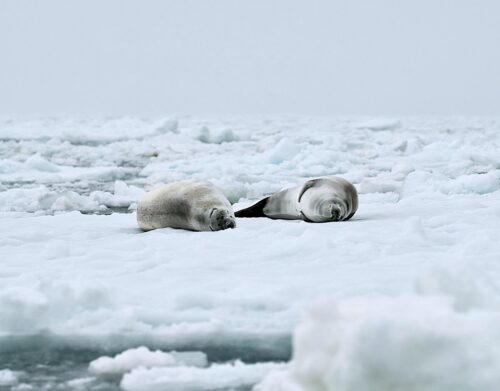In 1837, Swiss geologist Luois Agasizz’s proposed the Theory of Ice Ages, thereby revolutionizing our perception of Earth’s Polar Ice Caps. This new theory contended that huge blankets of Ice ebbed and flowed through time across vast regions of the northern and southern hemisphere (Figure 1). We now understand that these long-term (11,000 year) major ice age cycles are controlled by regular variations in Earth’s orbit and tilt within the Solar System, so-called Milankovitch Cycles.

Well, a new and equally significant revolution in Polar Ice Cap science is about to occur.
This latest revolution will completely change how we perceive short-term variations in Polar Ice Sheet ebb and floe characteristics. It has become obvious based on recent research studies that geological forces, primarily in the form of present-day high-temperature geothermal heat and fluid flow act to dramatically affect nearly every aspect of our Polar Ice Cap regions, such as:
- Increasing the temperature and altering the chemistry of surrounding ocean waters.
- Influencing marine and land animal migration patterns.
- Affecting the strength and frequency of major ocean plankton blooms.
- Melting the base of glacial ice sheets located above major geothermally active bedrock fault zones.
In the very near future all scientists, including those favoring the theory of man-made Global Warming, will realize that natural geological and atmospheric forces work in concert to control short term variations in our Polar Ice Caps. This new and revolutionary way of perceiving our Polar Ice Caps is best explained by the Plate Climatology Theory.
Evidence supporting this contention is as follows.
Research studies completed during the last two years have substantiated the affect geological forces have had on Polar Ice Caps, and have been the focus of many Climate Change Dispatch (CCD) articles. The reader can access these articles by utilizing the following hyperlinks: Greenland Ice Sheet Melting (see here and here), Arctic Sea Ice Melting (see here and here), West Antarctic Rift / Fault System Volcanic Activity and Geothermal Heat Flow (see here and here), and Svalbard Island Glacial Melting Along the Mid-Atlantic Rift / fault System (see here).
Sadly all previous research studies and the CCD articles have not acted to convince the science community to alter its “atmospheric bias.” Most scientists still hold on to the notion that observed natural changes in the Polar Ice Caps are driven exclusively by the atmosphere.
A just released research study may end up being the catalyst that finally gets the Polar Ice Cap scientists to change their minds. The new study documents the discovery of yet another huge sub-glacial East Antarctic freshwater lake (Figure 2).

This new lake is definitely not generated by global warming. It is 370 miles inland from the ocean, and as a result it would be nay impossible to flow warmed seawater uphill for this distance and onto the base of the ice sheet. The lake is located beneath approximately 7,000 feet of ice and therefore not exposed to the atmosphere. Scientists involved in this study have stated that the sub-glacial / bedrock long-linear valleys that cut across this portion of East Antarctica were generated by faults (Figure 2). The new lake lies nested in one of these long linear bedrock sub-glacial fault valleys.
Furthermore, researchers state that the pattern of the faults strongly suggests that they are part of a major continental rift system (see quote below). This is an amazing geological realization. Major rift systems are fault zones that act to rip entire continents apart and in the process generate large vertical fractures / faults that tap vertically downward into hot lava pockets. Once tapped, these hot lava pockets act to capture, heat, and circulate super-heated freshwater upwards to the bedrock surface.
“The region beneath Princess Elizabeth Land is so exciting that geologists are making wilder predictions, too: First, Jamieson suspects that the linear features, or canyons, might actually point to rifting (faulting), where two tectonic plates are prying themselves apart. Second, Neil Ross from Newcastle University in England, a co-author on the study, speculates that the lake could contain microbial life. Any microbes would “have been isolated from the rest of the planet for an awful long time and might have unique adaptations as a result,” he says. Such microbes could aid our search for life in the outer solar system.”
In the case of this newly discovered East Antarctic freshwater lake it is very likely that rift / fault-induced heat flow has circulated up and onto the base of the glacial ice sheet and acted to melt the base of the ice. This melted freshwater has pooled up within the long linear bedrock fault valley thus creating a sub-glacial freshwater lake.
This may all seem a bit speculative; however, it is not. This exact geological set-up is proven to exist in another East Antarctic sub-glacial freshwater lake: Lake Vostok (Figure 3).

East Antarctica’s Lake Vostok lies above a major fault valley and its outline is “linear” (160 miles long by 30 miles wide). This linear configuration and position above a fault-induced valley are strikingly similar to the newly discovered sub-glacial lake. Several wells have been drilled into Lake Vostok proving that it was created, and is maintained by current-day high-heat flow from bedrock hot springs. These hot springs are likely fed by heat flow up the underlying fault zone.
Water samples from Lake Vostok contain very unusual biotic constituents that are found only in hot springs. Elevation profiles of the bedrock surface of lake Vostok clearly show a cone shaped feature that acts to separate the lake into two segments, a larger “southern main lake basin” and a smaller “embayment” segment (Figure 3). The cone shaped feature has been interpreted as a small volcano that is likely emitting super-heated freshwater.
Ice sheets in Greenland, Svalbard Islands, West Antarctica, Central Antarctica, and now East Antarctica all have been dramatically affected by geological forces. This amounts to absolutely overwhelming proof that geological forces play a significant and likely primary role in driving observed short-term natural changes in Earth’s Polar Ice Caps. It is no longer proper to attribute the cause of these changes exclusively to man-made atmospheric global warming.
James Edward Kamis is a Geologist and AAPG member of 42 years with a B.S. and M.S. in geology who has always been fascinated by the connection between Geology and Climate. More than 11 years of research / observation have convinced him that the Earth’s Heat Flow Engine, which drives the outer crustal plates, is also an important driver of the Earth’s climate. The Plate Climatology Theory (plateclimatology.com) was recently presented at the annual 2016 American Meteorological Society Conference in New Orleans, LA.
REFERENCES
http://www.livescience.com/38652-what-is-lake-vostok.html
http://advances.sciencemag.org/content/advances/1/6/e1500093.full.pdf
http://geology.gsapubs.org/content/early/2015/12/22/G37220.1.full.pdf
http://news.ucsc.edu/2015/07/antarctic-heating.html
http://www.earthweek.com/2013/ew130315/ew130315a.html
https://www.ldeo.columbia.edu/~mstuding/vostok.html
https://weather.com/science/environment/news/scientists-discover-antarctica-lake
http://geology.gsapubs.org/content/early/2015/12/22/G37220.1.abstract
https://weather.com/science/environment/news/mysterious-crater-antarctica
http://onlinelibrary.wiley.com/doi/10.1029/2005GL025207/pdf
http://www.nbcnews.com/science/antarcticas-hidden-lake-vostok-found-teem-life-6C10561955


















